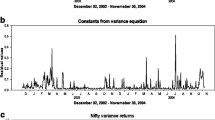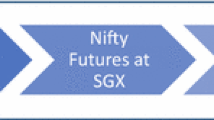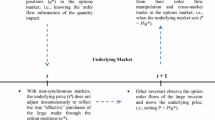Abstract
This article studies the profitability and arbitrage efficiency of the Chicago Mercantile Exchange (CME) Nikkei 225 futures. As one of the most typical quanto derivatives in the world, the CME Nikkei futures is traded in dollars while the underlying Nikkei index is traded in yen. The special characteristic involves more complicated uncertainties, which necessitate an investigation into its profitability and efficiency. To this end, we construct an arbitrage-free quanto pricing model to examine the mispricing of the CME Nikkei futures and the underlying spot prices for potential arbitrage opportunities. Distinguishing an ex-post trading rule from an ex-ante trading rule, we conduct non-parametric moving block bootstrap simulations to test the significance of profitability in the CME. The results show insignificant ex-post profitability but significant ex-ante profitability before and after the 2008 global financial crisis. Moreover, delayed execution significantly impacts the futures profitability. Profitable arbitrage opportunities are confirmed by implied transaction costs and explained by lagged absolute mispricing, lagged error, futures time to maturity, stock volatility, and trading volume in the CME. These findings have important implications for practitioners in their cross-border arbitrage trades, and for policy makers in their regulation of quantos in futures globalization.






Similar content being viewed by others
Notes
Yen-denominated Nikkei 225 futures are simultaneously listed on the Osaka Exchange and the Singapore Exchange, apart from the CME. The Singapore Exchange starts to trade dollar-denominated Nikkei 225 futures from 2006, which is not considered in this article due to the relatively short time series.
This is based on the aforementioned Nikkei dividend payment practice that most Nikkei firms pay dividends in the last two weeks of June (year-end) and the first two weeks of December (interim). We follow Qin et al. (2019) to use the assumption to derive the arbitrage-free quanto pricing model.
The reason for rescaling further by 100 in Eq. (8) is that the RM is expressed in percent of the index.
Data are obtained from the CME and Datastream.
Tu et al. (2016) report an overwhelming amount of concurrent volatility in futures mispricing during the GFC.
Transaction costs of arbitraging the CME Nikkei futures comprise brokerage commissions in the spot and futures markets, interest costs or short-selling costs in the spot market, Globex fees, clearing fees in the open outcry and Globex, market impact costs in the spot and futures markets, and currency conversion costs. These vary between investor groups and are subject to regulatory changes.
The estimation is based on the literature. For example, Białkowski and Jakubowski (2008) assume the transaction costs to be 0.3%, 0.6% and 0.9% in the Polish WIG20 futures market, each of which corresponds to a group of institutional investors. Zhang and Urquhart (2018) set the transaction costs of pairs trading between mainland China and Hong Kong stock markets at 1% per trade. Qin et al. (2019) estimate the index arbitrage transaction costs to be 1.5% and 2.0% for brokers and institutional investors, respectively, for the CME Nikkei 225 futures. We follow these studies to ignore the time value of transaction costs for simplicity.
The margin set by the CME is $4,000 for a Nikkei 225 futures contract at the end of the sample.
Results are available on request. Unit root tests suggest that the absolute mispricing is stationary; these results are also available on request.
We further tried the following dummy variables in the regression. Negative basis could exert a larger effect on the size of mispricing than positive basis (Wang 2011). Thus, a dummy variable was added to the regression to check the possible asymmetric effect of basis. Additional dummy variables were added to check the effect of time-related anomalies, including the weekend effect and the mid-of-the-week effect, and whether there are monthly patterns recognizable in the mispricing series. We find that the dummy variables tend to be insignificant and make overparametrized models. This indicates that the asymmetric effect of basis, and the time-related patterns may not be important in the CME Nikkei market, and therefore these dummies are not included in Eq. (9).
We thank an anonymous reviewer for the suggestion.
References
Bassiouny, A., & Tooma, E. (2021). Intraday indirect arbitrage between European index ETFs. International Review of Financial Analysis, 75, 1–13. https://doi.org/10.1016/j.irfa.2021.101737
Baxter, M., & Rennie, A. (1996). Financial calculus: An introduction to derivative pricing. Cambridge University Press.
Białkowski, J., & Jakubowski, J. (2008). Stock index futures arbitrage in emerging markets: Polish evidence. International Review of Financial Analysis, 17, 363–381. https://doi.org/10.1016/j.irfa.2006.10.004
Białkowski, J., & Perera, D. (2019). Stock index futures arbitrage: Evidence from a meta-analysis. International Review of Financial Analysis, 61, 284–294. https://doi.org/10.1016/j.irfa.2018.09.002
Bollerslev, T. (1986). Generalized autoregressive conditional heteroskedasticity. Journal of Econometrics, 31(3), 307–327. https://doi.org/10.1016/0304-4076(86)90063-1
Brenner, M., Subrahmanyam, M. G., & Uno, J. (1989). The behavior of prices in the Nikkei spot and futures market. Journal of Financial Economics, 23(2), 363–383. https://doi.org/10.1016/0304-405X(89)90063-9
Broussard, J. P., & Vaihekoski, M. (2012). Profitability of pairs trading strategy in an illiquid market with multiple share classes. Journal of International Financial Markets, Institutions & Money, 22(5), 1188–1201. https://doi.org/10.1016/j.intfin.2012.06.002
Bühler, W., & Kempf, A. (1995). DAX index futures: Mispricing and arbitrage in German markets. Journal of Futures Markets, 15(7), 833–859. https://doi.org/10.1002/fut.3990150706
Chen, J., Cai, C. X., Faff, R., & Shin, Y. (2022). Nonlinear limits to arbitrage. Journal of Futures Markets, 42(6), 1084–1113. https://doi.org/10.1002/fut.22320
Cheng, T. Y., Lee, C. I., & Lin, C. H. (2020). The effect of risk-taking behavior on profitability: Evidence from futures market. Economic Modelling, 86, 19–38. https://doi.org/10.1016/j.econmod.2019.04.017
Cornell, B., & French, K. R. (1983). Taxes and the pricing of stock index futures. Journal of Finance, 38, 675–694. https://doi.org/10.1111/j.1540-6261.1983.tb02496.x
Cummings, J. R., & Frino, A. (2011). Index arbitrage and the pricing relationship between Australian stock index futures and their underlying shares. Accounting and Finance, 51, 661–683. https://doi.org/10.1111/j.1467-629X.2010.00365.x
Ding, W., Mazouz, K., & Wang, Q. (2021). Volatility timing, sentiment, and the short-term profitability of VIX-based cross-sectional trading strategies. Journal of Empirical Finance, 63, 42–56. https://doi.org/10.1016/j.jempfin.2021.05.003
Fung, J. K. W., & Draper, P. (1999). Mispricing of index futures contracts and short sales constraints. Journal of Futures Markets, 19(6), 695–715. https://doi.org/10.1002/(SICI)1096-9934(199909)19:6%3c695::AID-FUT4%3e3.0.CO;2-H
Gay, G. D., & Jung, D. Y. (1999). A further look at transaction costs, short sale restrictions, and futures market efficiency: The case of Korean stock index futures. Journal of Futures Markets, 19(2), 153–174. https://doi.org/10.1002/(SICI)1096-9934(199904)19:2%3c153::AID-FUT2%3e3.0.CO;2-S
Gould, F. J. (1988). Stock index futures: The arbitrage cycle and portfolio insurance. Financial Analysts Journal, 44(1), 48–62. https://doi.org/10.2469/faj.v44.n1.48
Gu, M., Kang, W., & Xu, B. (2018). Limits of arbitrage and idiosyncratic volatility: Evidence from China stock market. Journal of Banking and Finance, 86, 240–258. https://doi.org/10.1016/j.jbankfin.2015.08.016
Hemler, M. L., & Longstaff, F. A. (1991). General equilibrium stock index futures prices: Theory and empirical evidence. Journal of Financial and Quantitative Analysis, 26(3), 287–308. https://doi.org/10.2307/2331208
Itkin, A., & Soleymani, F. (2021). Four-factor model of Quanto CDS with jumps-at-default and stochastic recovery. Journal of Computational Science, 54, 101434. https://doi.org/10.1016/j.jocs.2021.101434
Jacobs, H., & Weber, M. (2015). On the determinants of pairs trading profitability. Journal of Financial Markets, 23, 75–97. https://doi.org/10.1016/j.finmar.2014.12.001
Kanamura, T., Homann, L., & Prokopczuk, M. (2021). Pricing analysis of wind power derivatives for renewable energy risk management. Applied Energy, 304, 117827. https://doi.org/10.1016/j.apenergy.2021.117827
Kempf, A. (1998). Short selling, unwinding, and mispricing. Journal of Futures Markets, 18(8), 903–923. https://doi.org/10.1002/(SICI)1096-9934(199812)18:8%3c903::AID-FUT2%3e3.0.CO;2-V
Kim, Y. S., Lee, J., Mittnik, S., & Park, J. (2015). Quanto option pricing in the presence of fat tails and asymmetric dependence. Journal of Econometrics, 187(2), 512–520. https://doi.org/10.1016/j.jeconom.2015.02.035
Lee, H., Ha, H., & Lee, M. (2023). Partial quanto lookback options. North American Journal of Economics and Finance, 64, 101871. https://doi.org/10.1016/j.najef.2022.101871
Li, S., Huang, H. H., & Zhang, T. (2020). Generalized affine transform on pricing quanto range accrual note. North American Journal of Economics and Finance, 54, 100892. https://doi.org/10.1016/j.najef.2018.12.004
MacKinlay, A. C., & Ramaswamy, K. (1988). Index-futures arbitrage and the behavior of stock index futures prices. Review of Financial Studies, 1(2), 137–158. https://doi.org/10.1093/rfs/1.2.137
Malkiel, B. G., & Fama, E. F. (1970). Efficient capital markets: A review of theory and empirical work. Journal of Finance, 25, 383–417. https://doi.org/10.2307/2325486
McDonald, R. L. (2013). Derivatives markets (3rd ed.). Pearson.
Mignani, S., & Rosa, R. (1995). The moving block bootstrap to assess the accuracy of statistical estimates in Ising model simulations. Computer Physics Communications, 92(2–3), 203–213. https://doi.org/10.1016/0010-4655(95)00114-7
Miller, M. H., Muthuswamy, J., & Whaley, R. E. (1994). Mean reversion of Standard & Poor’s 500 index basis changes: Arbitrage-induced or statistical Illusion? Journal of Finance, 49(2), 479–513. https://doi.org/10.2307/2329160
Nam, S. O., Kim, H. K., & Kim, B. C. (2010). An alternative approach to evaluating the agreement between financial markets. Journal of International Financial Markets, Institutions and Money, 20, 13–35. https://doi.org/10.1016/j.intfin.2009.11.001
Newey, W. K., & West, K. D. (1987). A simple, positive semi-definite, heteroscedasticity and autocorrelation consistent covariance matrix. Econometrica, 55(3), 703–708. https://doi.org/10.2307/1913610
Pu, Y., & Yang, B. (2022). The commodity futures’ historical basis in trading strategy and portfolio investment. Energy Economics, 105, 1–15. https://doi.org/10.1016/j.eneco.2021.105780
Qin, J., Green, C. J., & Sirichand, K. (2019). Determinants of Nikkei futures mispricing in international markets: Dividend clustering, currency risk, and transaction costs. Journal of Futures Markets, 39(10), 1269–1300. https://doi.org/10.1002/fut.22038
Qin, J., Green, C. J., & Sirichand, K. (2023). Spot–futures price adjustments in the Nikkei 225: Linear or smooth transition? Financial centre leadership or home bias? Journal of Risk and Financial Management, 16(117), 1–31. https://doi.org/10.3390/jrfm16020117
Richie, N., Daigler, R. T., & Gleason, K. C. (2008). The limits to stock index arbitrage: Examining S&P 500 futures and SPDRS. Journal of Futures Markets, 28(12), 1182–1205. https://doi.org/10.1002/fut.20365
Shleifer, A., & Vishny, R. W. (1997). The limits of arbitrage. Journal of Finance, 52(1), 35–55. https://doi.org/10.2307/2329555
Sutcliffe, C. M. S. (2006). Stock index futures (3rd ed.). Ashgate.
Tse, Y. (2001). Index arbitrage with heterogeneous investors: A smooth transition error correction analysis. Journal of Banking and Finance, 25(10), 1829–1855. https://doi.org/10.1016/S0378-4266(00)00162-X
Tu, A. H., Hsieh, W. L. G., & Wu, W. S. (2016). Market uncertainty, expected volatility and the mispricing of S&P 500 index futures. Journal of Empirical Finance, 35, 78–98. https://doi.org/10.1016/j.jempfin.2015.10.006
Wang, J. (2011). Price behavior of stock index futures: Evidence from the FTSE **nhua China A50 and H-share index futures markets. Emerging Markets Finance and Trade, 47(Supplement 1), 61–77. https://doi.org/10.2753/REE1540-496X4701S106
Wang, X. (2022). Pricing vulnerable options with stochastic liquidity risk. North American Journal of Economics and Finance, 60, 101637. https://doi.org/10.1016/j.najef.2021.101637
Yadav, P. K., & Pope, P. F. (1994). Stock index futures mispricing: Profit opportunities or risk premia? Journal of Banking and Finance, 18(5), 921–953. https://doi.org/10.1016/0378-4266(94)00026-3
Zhang, H., & Urquhart, A. (2018). Pairs trading across Mainland China and Hong Kong stock markets. International Journal of Finance and Economics, 24, 698–726. https://doi.org/10.1002/ijfe.1687
Zhang, H., & Watada, J. (2019). An analysis of the arbitrage efficiency of the Chinese SSE 50ETF options market. International Review of Economics and Finance, 59, 474–489. https://doi.org/10.1016/j.iref.2018.10.011
Acknowledgements
We wish to thank Christopher J. Green, Kavita Sirichand and two anonymous reviewers for helpful comments.
Funding
This work was supported by Natural Science Foundation of Anhui Province, China [grant number 2008085QG347].
Author information
Authors and Affiliations
Corresponding author
Ethics declarations
Conflict of interest
The authors declare that they have no conflict of interest.
Ethical Approval
The authors declare that the experiments in this article comply with the current laws of the country in which they were performed.
Additional information
Publisher's Note
Springer Nature remains neutral with regard to jurisdictional claims in published maps and institutional affiliations.
Appendix
Appendix
1.1 The Relative Stability of the Gensaki Rate
The Gensaki Treasury bill overnight rate is a proxy for the risk-free rate in the arbitrage-free quanto pricing model, Eqs. (5) and (6). Figure 7 shows that the Gensaki rate is relatively stable and fluctuations tend to be small given the scale of the vertical axis. The Gensaki rate is stochastic but the uncertainty about the rate is likely to be less important.
Rights and permissions
Springer Nature or its licensor (e.g. a society or other partner) holds exclusive rights to this article under a publishing agreement with the author(s) or other rightsholder(s); author self-archiving of the accepted manuscript version of this article is solely governed by the terms of such publishing agreement and applicable law.
About this article
Cite this article
Qin, J. The Profitability and Arbitrage Efficiency of the Chicago Mercantile Exchange Nikkei 225 Futures. Asia-Pac Financ Markets (2024). https://doi.org/10.1007/s10690-024-09469-4
Accepted:
Published:
DOI: https://doi.org/10.1007/s10690-024-09469-4





